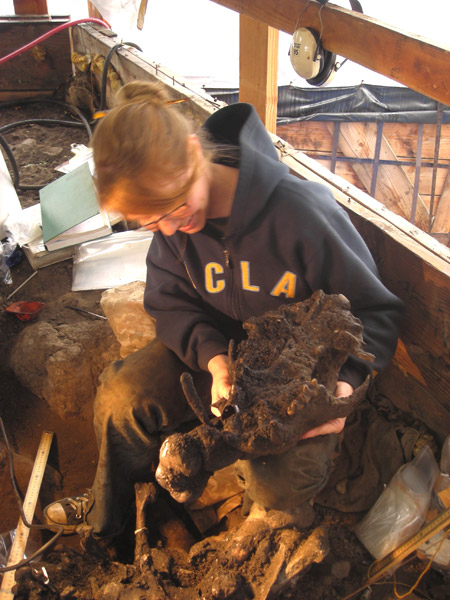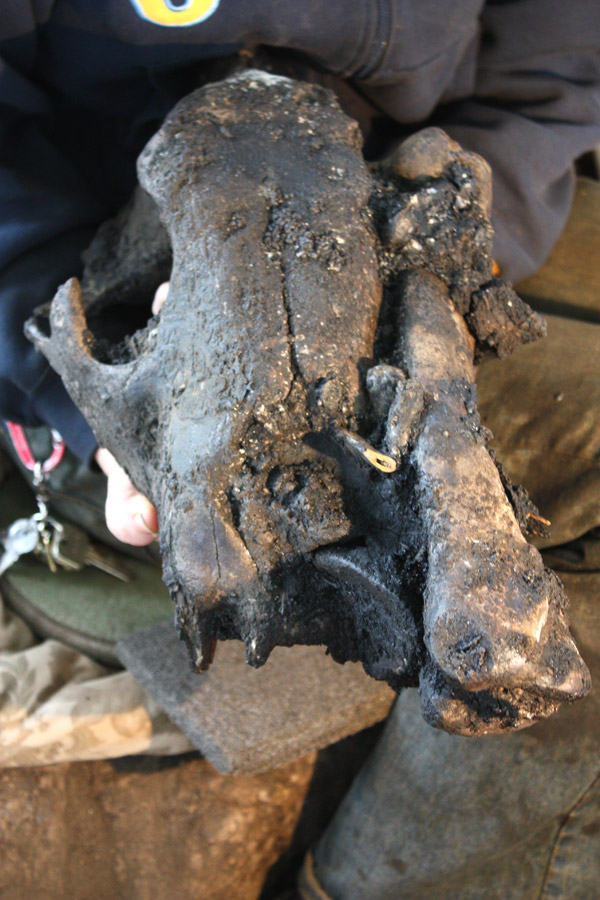Remember this?
That, paleo-friends, is the skull of a North American Lion -- Panthera atrox. We finally finished removing all the bones around it, and thus successfully excavated the skull!
But first, here are some interesting inferences about North American Lions, provided by our fair leader, collections manager Christopher A Shaw:
- North American Lions showed up in their eponymous continent (North America) around 400k years ago
- They were probably not social animals -- in other words, there were no prides of these particular lions. We think this for two reasons:
- We don't find nearly as many of them as we do dire wolves and sabertooth cats, and not with nearly the same range of ontogenetic age. For example, we've found approximately 6 North American Lions in Pit 91, compared to around 50 Saber-toothed Cats.
- In a pride of African lions, the ratio of males to females is 1:6 or 1:7. Here at Rancho La Brea the ratio is about 1:1. Thus: no African Lion-esque prides. North American Lions likely had a more solitary lifestyle, more akin to that of a mountain lion.
Back to our skull: after months of carefully using dental picks to clear out the surrounding matrix, we eventually had to resort to brute force to get the lion skull out.
That's me on the left, Michelle on the right. I'm rocking the skull back and forth on its side to loosen it from the surrounding matrix; Michelle is holding on to a bone underneath the skull to keep it from coming out along with the lion. Aisling wisely thought to film the entire process:
Background soundtrack provided by: Marketplace with Kai Ryssdal on NPR; Laura Tewksbury singing; various lab volunteers cheering; and me saying "there's a frickin humerus attached to it!" A great orator, I am not...
Though quality on this video isn't the best, it is good enough to show just how tough it is to get something out of an asphaltic deposit. Even after putting all of my weight behind the skull, at first it barely moves. However, after some artful wiggling (and a decent amount of luck) it's out!
The skull itself is an absolutely beautiful specimen; it's the most complete P. atrox skull we've gotten out of the current excavations (i.e. Pit 91 and Project 23).
Look at all those bones I could have damaged had I continued using a dental pick! The crescent shaped bone in the lion's mouth is a horse hoof; there's a complete saber cat rib in the back; and yes, on the right -- there's a fricken humerus attached to it. Sabertoothed cat humerus, to be exact.
And now that the skull's out, we can get on with our excavation.
These are just a few of the bones that are now accessible thanks to the skull's removal. Click the picture above to be taken to our flickr site, where you can mouse-over individual bones and find out what they are.
As for our skull...
Laura promptly carried it off to the lab, and rumor has it that Herb will begin cleaning it in a few weeks. We think we'll name it Fluffy.










2 comments:
Wow! that is one sweet lion skull!
Question: Do you know if there has there been any discoveries of Homotherium material from la brea?
I have read passing mentions that there might be but I have yet to find any certain sources.
I finally read this one...
Woot. And for Fluffy, which makes this a double-woot.
Spencer
Post a Comment